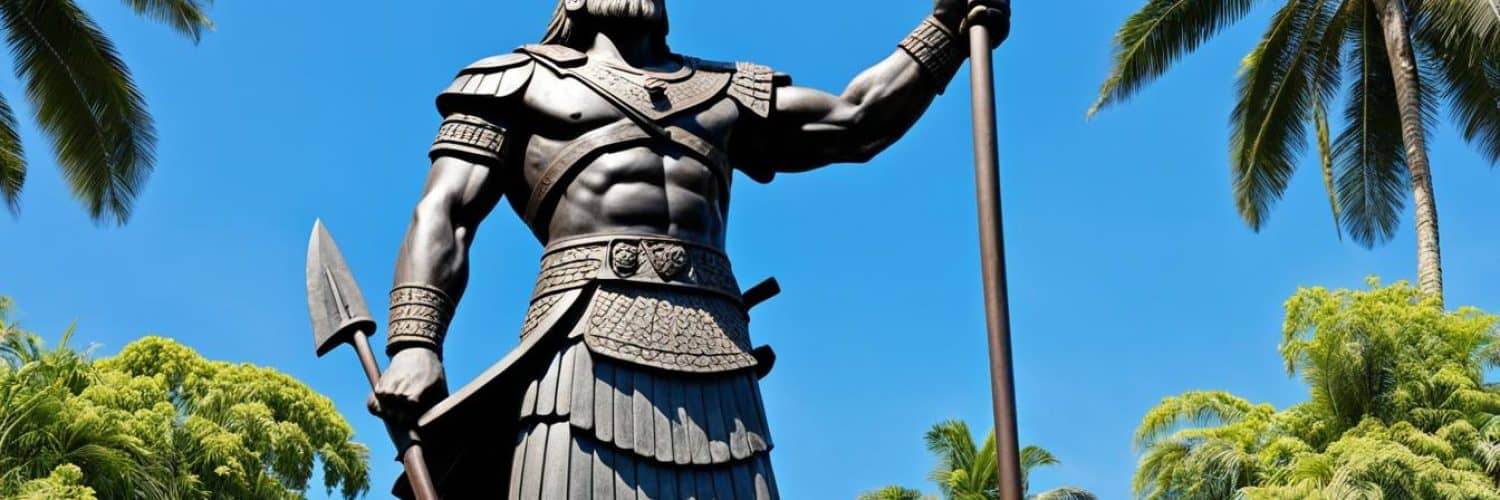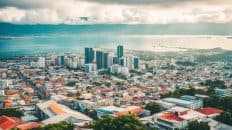Steeped in history and cultural significance, the Lapu-Lapu Monument in Cebu Philippines marks the site of heroism and the rich heritage of the Filipino people. As a celebrated tourist attraction and a poignant historical landmark, this memorial becons globetrotters and history aficionados alike, providing a window into the past through the eyes of a revered Filipino hero. Surrounded by the stunning backdrop of the Mactan Shrine, the monument stands as an emblem of the nation’s proud cultural heritage.
Key Takeaways
- The Lapu-Lapu Monument honors a historic Filipino figure of resistance.
- It serves as a vital piece of the Philippine cultural heritage and history.
- Located in Mactan Shrine, the monument is accessible to visitors in Cebu.
- This tourist attraction is set within a vista that captivates and educates.
- A visit to the monument offers a deeper understanding of the Philippines’ past.
Lapu-Lapu Monument, Cebu Philippines: A Legacy Cast in Bronze
The Lapu-Lapu Monument, a significant monument on Mactan Island, stands as a towering figure in Philippine history. This grandiose bronze statue which reaches up to 6 meters in height, serves as a steadfast reminder of the indigenous bravery and strategic prowess that characterized the battle of Mactan. Erected in 1981, this historical sentinel honors the country’s first hero, whose valorous spirit is encapsulated in every intricate detail of the sculpture.
Admired by both local citizens and visitors from afar, the monument not only pays tribute to the past but also inspires the present. It’s a site where Filipino cultural pride is palpable, and a place that beckons tourists to delve deeper into the rich tapestry of the nation’s storied past. Here’s a snapshot of the monument’s attributes:
| Feature | Description |
|---|---|
| Height | 20 feet (approximately 6 meters) |
| Material | Bronze |
| Inaugurated | 1981 |
| Location Significance | Site of the historic battle of Mactan |
| Cultural Impact | Embodies the valor and leadership of Lapu-Lapu |
At the heart of the monument’s legacy is the unwavering symbol of resistance against colonization. It serves not just as a physical structure, but as an enduring beacon of nationalism and the enduring spirit of the Filipino people.
The Historical Significance of the Monument
The towering presence of the Lapu-Lapu Monument within the Mactan Shrine is a testament to the enduring legacy of the Filipino hero, Lapu-Lapu. Erected to immortalize his victory, this historical landmark serves as a reminder of the Battle of Mactan, which has become a source of national pride and a keystone of Philippine cultural heritage.
The Battle of Mactan and Its Hero
On the morning of April 27, 1521, the shores of Mactan Island became the stage for a pivotal clash that would forever change the course of Philippine history. The Filipino warrior Lapu-Lapu led a formidable defense against the Spanish forces led by Ferdinand Magellan. This encounter not only represents Filipino bravery and strategic intelligence but is also celebrated as the moment a native leader affirmed his people’s sovereignty against foreign dominion.
Establishment and Recognition as a National Shrine
In the year 1969, under the governance of President Ferdinand Marcos, this site where Lapu-Lapu claimed his triumph was officially recognized as a national shrine. This honor came nearly four and a half centuries after the historic confrontation and reflects the country’s dedication to preserving its storied past. Accompanied by the Magellan Monument, the area serves as a ground of reflection for the nation and its cultural and historical path.
Architectural Wonders: Unveiling the Structure of the Lapu-Lapu Monument
Among the myriad architectural wonders in the Philippines, the Lapu-Lapu Monument holds a special place in the heart of Lapu-Lapu City. This imposing bronze sculpture not only symbolizes the valor of a historical hero but is also a masterpiece of artistry capturing the essence of Filipino bravery and artisanship. From each defined muscle on the warrior’s body to the intricate patterns on his armor, every aspect of the monument underlines the rich cultural and historical narrative of the Philippines.
Diving deeper into its structural attributes, we uncover a tale of aesthetics that intersect with the principles of honor and homage. Bearing the weight of history, the monument showcases exquisite craftsmanship—a true testament to not only the hero it stands for but also to the artists and architects who brought it to life.
- The stance of the statue, poised for battle, represents unyielding determination and strength.
- The expression on Lapu-Lapu’s face, a mixture of defiance and resolve, perpetuates the spirit of Filipino independence.
- The bronze material used, a durable and timeless metal, symbolizes the permanence of Lapu-Lapu’s legacy.
In appreciating the monumental tribute, one cannot help but marvel at the national pride and identity embedded in its form. This table elucidates the specifics that make the Lapu-Lapu Monument a true spectacle:
| Feature | Detail | Symbolism |
|---|---|---|
| Height | 20 feet | Stature reflecting leadership and visibility in history |
| Material | Bronze | Endurance and legacy |
| Attire | Traditional Warrior’s Dress | Cultural authenticity and honor to ancestral heritage |
| Base | Stone Pedestal | Sturdy support signifying the foundation of freedom |
With its grandeur and dignified poise, the Lapu-Lapu Monument in Lapu-Lapu City not only fascinates tourists but also instills a sense of pride among the Filipinos. It thereby stands as an unyielding symbol in the realm of architectural wonders, immortalizing an ethos that transcends time and history.
Navigating Mactan Island: Location and Accessibility
Set in the heart of Central Visayas, Mactan Island emerges as a premier tourist attraction, with the Lapu-Lapu Monument as its historic jewel. Accessing this iconic piece of Cebu Philippines’ heritage is a journey that is both easy and enriching, thanks to the island’s excellent location and accessibility.
Getting There: Transportation Options
Reaching the timeless Lapu-Lapu Monument is straightforward, whether you are navigating from within Cebu or journeying from afar. Public transportation provides convenient options with routes 23 and MI-01A that bring visitors to the entry point of Punta Engaño. Taxis, ride-hailing services, and rental scooters offer personalized alternatives, allowing for a pace and path tailored to your travel whims.
- Public Buses: Wide coverage with frequent schedules
- Jeepneys: A quintessential Philippine experience
- Taxis and Ride-Hailing: Comfortable, door-to-door service
- Rentals: Flexibility to explore beyond the beaten path
Coordinates and Map Insights
For the cartographically inclined or those reliant on GPS technology, the Lapu-Lapu Monument is charted at 10°18′39″N 124°0′54.8″E. Nestled within Metro Cebu, it is a beacon for travellers seeking a touchstone of cultural pride and historical significance.
| Method | Accessibility | Duration |
|---|---|---|
| Public Transit | Direct routes to destination | Varies by location |
| Private Transport | On-demand travel | Dependent on traffic |
| By Foot | Scenic and leisurely | Enjoy at your own pace |
With its approachable location, getting to the Mactan Island landmark is a testament to the island’s commitment to showcase its vibrant heritage. Whether for a day trip or an extended stay on Cebu, the monument’s accessibility ensures it remains a must-visit historical attraction.
Exploring the Vicinity: Nearby Attractions and Activities
Beyond the historic grounds where the great Lapu-Lapu Monument stands, Mactan Island beckons with its rich cultural heritage visible in numerous nearby attractions. Visitors to this island can experience a journey through history while also immersing themselves in the vibrant local culture through a range of festivals and events that showcase the region’s traditions and communal spirit.
Adjacent Historical Landmarks
The region’s past is depicted through landmarks scattered around the Monument. The Magellan Monument, though touched by the ravages of typhoon Odette, remains a poignant reflection of the island’s storied past. Not far, the Mactan Shrine offers a window into the Filipino identity, allowing visitors to walk the path once tread by historic figures of the Philippines.
Engaging in Local Culture: Festivals and Events
Mactan Island is not just a silent witness of the past; it’s a living, breathing canvas of today’s local culture. Events such as the ‘Kadaugan sa Mactan’ bring history back to life with dramatic flair, featuring colorful reenactments that depict the legendary battle. Alongside these historical representations are festivities filled with traditional music, dance, and a showcase of Filipino hospitality that promise an unforgettable experience deeply rooted in the island’s cultural heritage.
- Experience the Battle of Mactan through the annual ‘Kadaugan sa Mactan’ reenactment
- Dive into traditional Filipino festivities, teeming with indigenous music and dance
- Join the local community in seasonal celebrations that reflect the island’s vibrant spirit
Visitor Experiences: Reviews and Suggestions
Exploring the Lapu-Lapu Monument immerses you in the Philippines’ rich history, and visitor experiences are invaluable for enriching the journey of future travelers. Tourist reviews have consistently praised the site for its informative and inspirational portrayal of Filipino culture. Below we delve into the personal narratives and travel tips shared by visitors, offering a composite guide to maximize your visit to this iconic landmark.
Immersion and Learning from Travelers’ Stories
Many tourists emphasize the profound impact the Lapu-Lapu Monument had on their understanding of Philippine history and culture. From accounts of awe at the first sight of the monument to touching descriptions of the emotional resonance felt during the visit, these stories offer a glimpse into what future visitors might expect. Here is a snapshot of recent visitor testimonials:
“Standing before the Lapu-Lapu Monument, I felt a deep sense of reverence for the courage depicted by the stoic bronze figure. It’s a humbling reminder of the country’s spirit of independence and the resilience of its people.”
“Our family’s visit to the Lapu-Lapu Monument turned into an unexpected history lesson for my kids. They learned about a hero they never knew before and were inspired by the rich narratives surrounding the Battle of Mactan.”
Tips for a Fulfilling Visit
Visitor insights also extend to travel tips aimed at enhancing the experience for others. The following are key recommendations curated from various tourist reviews:
- Plan your visit early in the morning or later in the afternoon to avoid the heat and the crowds.
- Allocate time to explore the adjacent historical sites for a more comprehensive cultural tour.
- Engage with local guides for a detailed account of the historical events represented at the site.
- Visit nearby eateries and shops to experience local flavors and crafts.
To further assist in planning your trip, we have consolidated key information on the best experiences at the Lapu-Lapu Monument into the following table:
| Activity | Details | Visitor Tips |
|---|---|---|
| Photography | Iconic photo opportunities with the monument and the park’s scenic backdrop. | Use natural morning light for the best photo effects. |
| Learning | Informative plaques around the monument provide historical context. | Take time to read and reflect on the inscriptions for full immersion. |
| Shopping | Local souvenir shops in proximity to the monument. | Support the community by purchasing authentic local merchandise. |
| Eating | Local and international cuisine available nearby. | Try the local delicacies for a complete cultural experience. |
We hope that understanding these visitor experiences and travel tips will help pave the way for an enriching visit to the Lapu-Lapu Monument, where history and heroism are celebrated amidst the beauty of Mactan Island.
The Artist and The Vision: The Making of Lapu-Lapu’s Statue
Delving into the origins of Lapu-Lapu’s statue, the town council’s decision in the 1930s to commission a monument instigated a curious turn of historical events. Initially, the artist charged with this task presented Lapu-Lapu donning a bow and arrow. However, this portrayal would soon be clouded by an ominous series of misfortunes that befell the town’s leaders.
In an intriguing twist of fate, the subsequent and unexpected deaths of three consecutive mayors were rumored amongst the constituents to be attributable to a curse emanating from Lapu-Lapu’s statue. In an effort to quell the unease and reverse the town’s misfortunes, Mayor Mariano Dimataga took it upon himself to alter the iconic imagery of the statue by replacing the bow and arrow with a wooden shield. This change seemed to appease whatever forces had been at play, as Mayor Dimataga then went on to enjoy a long and stable career in office. This peculiar anecdote has added a layer of mythology to the vision behind the monument, enriching its history with local legend and lending an air of mystique to its presence.
The resolute figure of Lapu-Lapu now stands valiantly with shield in hand, embodying the bravery and unyielding spirit of a hero who fiercely guarded his homeland. Today, those who gaze upon the statue are not only reminded of the historical significance of the Battle of Mactan but are also privy to the captivating folklore that has woven itself into the narrative of the monument’s existence.
Cultural Heritage: Understanding the Symbolism
The monument dedicated to Lapu-Lapu not only immortalizes a pivotal figure in Philippine history but also represents the enduring spirit of Filipino identity and the collective memory of national pride. This resonating symbol stands at the intersection of the past and the present, celebrating cultural heritage and reminding future generations of the importance of preserving it.
Lapu-Lapu’s Influence on Filipino Identity
Lapu-Lapu emerges as a national icon, representing the intrinsic bravery and indomitable will of the Filipino people. His valor in the Battle of Mactan has been woven into the nation’s fabric, deeply impacting the development of a Filipino identity based on resilience, integrity, and the relentless pursuit of freedom.
The Monument’s Role in National Pride
As a cornerstone of cultural symbolism, the monument elevates national pride and embodies the virtues of independence and sovereignty. Each year, festivities and civic ceremonies around the shrine serve as affirmations of solidarity, inspiring a collective national spirit that transcends the confines of time.
| Element of Symbolism | Significance to Filipino Identity | Contribution to National Pride |
|---|---|---|
| Lapu-Lapu’s Image | A symbol of courage and the archetype of a Filipino hero | Reminds citizens of the valor necessary to maintain sovereignty |
| The Battle of Mactan | Historical resistance against colonization | Embodies the struggle and eventual triumph over foreign domination |
| Annual Celebrations | Fosters national unity through shared heritage | Reinforces the importance of independence in the Filipino consciousness |
Intriguing Facts About the Monument’s Past
The storied history of the Lapu-Lapu Monument is filled with tales that merge folklore with the monument’s revered place in Philippine culture. One lesser-known yarn spins around the early depiction of Lapu-Lapu armed with a bow and arrow, an image believed to have cast a shadow over the city’s well-being. This enigmatic anecdote from the monument’s past invariably colors the way history enthusiasts view and appreciate this historical landmark.
The Curse of the Bow and Arrow
Local lore recounts an extraordinary period during which the Lapu-Lapu Monument, initially brandishing a bow and arrow, seemed to instigate a string of misfortunes, including the untimely demise of governing mayors. A collective sigh of relief was embraced by the community when the statue was altered, with the bow and arrow replaced by a shield. This fateful transformation coincided with an unanticipated period of prosperity and tranquility, effectively elevating the story to one of the most intriguing facts enveloping the monument’s past.
Renovations and Updates Through the Decades
Keeping with the spirit of preserving national heritage, the Lapu-Lapu and Magellan monuments have been beneficiaries of meticulous renovations and updates. The National Historical Commission of the Philippines (NHCP) has played a pivotal role in this endeavor.
| Year | Renovation | Updates |
|---|---|---|
| 1970s-1980s | Initial restoration and public engagement efforts | Structural reinforcement and aesthetic detailing |
| 1990s | Landscape redevelopment | Installation of informational plaques |
| 2000s | Upgrading of surrounding infrastructure | Enhanced visitor amenities |
| 2010s-Present | Periodic cleaning and conservation treatments | Integration of digital information systems |
Updates have been systematically applied to ensure that the monument stands as a profound statement of pride and reflection of the country’s tumultuous yet vibrant history. These efforts ensure that the shrine and its enigmatic backstory continue to captivate visitors with its grandeur and compelling narrative, shaping its role as a cornerstone of Philippine cultural heritage.
Planning Your Visit: Hours, Amenities, and Tours
Embarking on an adventure to the historic Lapu-Lapu Monument is an endeavor that benefits from advance preparation. Whether you’re a history aficionado or a casual sightseer, understanding the amenities and timing can vastly improve your experience. To assist in planning your visit, we’ve compiled some essential information that ensures you make the most of your journey to this famed Filipino landmark.
Best Times to Visit for Photography and Atmosphere
To capture the essence of the Lapu-Lapu Monument in its full glory, timing is everything. For photography enthusiasts, the soft golden light during the daytime offers ideal conditions to photograph the grandeur of the statue against the lush greenery and azure skies of Mactan. The park’s open-air setting means you’re free to roam and take in the serene ambiance without the constraints of typical tourist hours.
Facilities for Tourists’ Convenience
Accommodating the needs of tourists is a high priority in this historical site. The amenities surrounding the monument offer various conveniences such as local souvenir shops where you can purchase keepsakes to remind you of your visit. Additionally, indulge in delicious local delicacies from the nearby food vendors, which add a flavorful dimension to your experience. The availability of these tourists’ facilities ensures that your visit is as comfortable as it is enlightening.
Conclusion
The Lapu-Lapu Monument not only commands attention as a noteworthy historical landmark in Cebu, Philippines, but it also resonates deeply with the themes of courage and autonomy that are integral to the Filipino spirit. Erected in the heart of Mactan Island, this bronzed tribute to one of the nation’s most venerated heroes is a potent reminder of the Philippines’ storied past. As a focal point for remembrance, it bonds visitors with the collective memory of a struggle that shaped the nation.
Through its stature and symbolism, the monument successfully merges past with present, offering visitors from across the globe an immersive gateway into the rich tapestry of Philippine history. Indeed, the site’s blend of education and inspiration underscores its status as a premier tourist attraction, while also bolstering the patriotic esteem of the Filipino people. Tourists leave with a renewed understanding of the significance of Lapu-Lapu’s legacy and its ongoing impact.
In sum, the Lapu-Lapu Monument stands as more than a mere statue; it is a sanctuary where stories of valor give life to stone and bronze, where every visitor can grasp the undying fire of Filipino freedom and resilience. It remains a cornerstone of the Philippine cultural landscape, honoring the enduring legacy of a hero who once stood firm against the tides of history.
FAQ
What is the Lapu-Lapu Monument in Cebu Philippines?
The Lapu-Lapu Monument is a significant historical landmark in Cebu, Philippines that honours Lapu-Lapu, a Filipino hero known for his leadership during the Battle of Mactan. It is a popular tourist attraction that embodies Filipino cultural heritage.
Where is the Lapu-Lapu Monument located?
The Lapu-Lapu Monument is located on Mactan Island in Lapu-Lapu City, within the Mactan Shrine which is also known as Liberty Shrine.
Why is the Lapu-Lapu Monument important?
The monument is important because it represents the valor and leadership of Lapu-Lapu during the Battle of Mactan, a significant event in Philippine history. It serves as a symbol of cultural heritage and the country’s first act of resistance against foreign conquest.
How can I get to the Lapu-Lapu Monument?
You can reach the Lapu-Lapu Monument by various transportation options including public transit routes such as 23 and MI-01A that stop at Punta Engaño on Mactan Island, within Metro Cebu.
What other attractions are near the Lapu-Lapu Monument?
Nearby attractions include the Magellan Monument and the opportunity to engage in local culture through festivals and events such as ‘Kadaugan sa Mactan’.
What do visitors say about the Lapu-Lapu Monument?
Visitor reviews, frequently found on platforms like Tripadvisor, often highlight the historical significance of the site and offer practical tips for the best visiting experiences.
What is the story behind the original statue of Lapu-Lapu?
The original statue of Lapu-Lapu had a bow and arrow which was believed to be cursed after a series of unfortunate events. It was replaced with a wooden shield that, according to legend, lifted the curse.
What symbols reflect Lapu-Lapu’s influence on Filipino identity?
Lapu-Lapu’s image features prominently in national entities such as the Philippine National Police and the Bureau of Fire Protection, signifying his influence on Filipino identity and national pride.
Have there been any renovations or updates to the Lapu-Lapu Monument?
Yes, the Lapu-Lapu and Magellan monuments have undergone conservation work overseen by the National Historical Commission of the Philippines to ensure their preservation.
When is the best time to visit the Lapu-Lapu Monument?
The best time to visit the monument is during the daytime for optimal photography opportunities and to fully appreciate the site’s ambiance.
Are there any facilities for tourists at the Lapu-Lapu Monument?
Yes, there are several amenities nearby, including souvenir shops and food vendors, to provide tourists with local flavors and memorabilia.


















Add comment